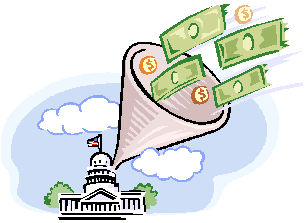 Time Consistent Monetary Policy
Time Consistent Monetary Policy
 Time Consistent Monetary Policy
Time Consistent Monetary Policy
Introduction
Is there an inflationary bias in the conduct of monetary policy? If an increase in the money supply is correctly anticipated by everyone, and all prices rise accordingly, then no firm will expand output and employment. It is only when households and firms incorrectly predict the rate of inflation that employment will increase. The consequence is that the central bank cannot credibly commit to an increase in money supply and inflation and still expect to have any impact on output and employment. That is, the central bank must announce one thing and do another. The period of high inflation and high unemployment is usually cited as an historical example. Paul Volker, then chairman of the Fed, had to engineer two recessions at the start of the 1980's in order to make his monetary policy credible.
Players
 |
Central Bank - Cares about hitting specific inflation and unemployment targets. |
 |
Workers - Care about income and leisure. Enter in to long term employment contracts specified in nominal wages rather than real wages. Workers must forecast the rate of inflation when they enter into a wage contract. If the rate of inflation turns out to be different from the forecasted rate then workers will supply either more or less labor then they had planned. |
 |
Firms - Care about profits. Firms will increase output and employment only if they think their price has risen relative to all other prices. |
Definitions
Lt - level of employment
Pt - price level
Mt - money supply
Wt - nominal wage rate
Rt - real wage rate
Pet - expected price level
![]() rate of inflation
rate of inflation
![]() expected rate of inflation
expected rate of inflation
gt = ln(Mt) - ln(Mt-1) rate of growth of money supply
rt = ln(Wt) - ln(Pt) real wage rate
A Normalization and an Assumption
The game is played over two periods. There are two advantages to working in logs. The first is that we can more easily talk about rates of change. The second is that logs allow us to 'normalize' certain key variables so that in log form they are translated to the origin. That is, they take a value of zero in the first period.
m1 = ln(M1) = 0
p1 = ln(P1) = 0
These two normalizations permit us to write

We will take an extreme monetarist position and assume that the rate of inflation is determined uniquely by the rate of growth of the money supply. That is,
![]()
Dynamics
Period 1: Workers choose a money wage at which they are willing to work.
Period
2:
2.1 The central bank chooses the rate of inflation.
2.2 Employers decide how many workers they will hire.
Strategies
Workers: w2 - workers choose a nominal wage at which to offer their services to the labor market.
Central Bank:
the central bank chooses an inflation policy after seeing the wage for which people have contracted to work.
Firms:
firms adopt an employment rule that depends on the real wage. When they choose the employment rule they have seen the nominal wage contract and they know the central bank's inflation policy.
Payoffs
Workers value income and leisure. We will say that the aggregate amount of labor supplied to the market is an increasing function of the real wage rate. This means that workers contract for a nominal wage in the first period, but then adjust the amount of labor the supply to the market upon seeing the market clearing real wage in period two. Specifically,
in which
is the elasticity of labor supply. If the real wage declines by 1% then the amount of labor supplied to the market will decline by
%. When it comes down to it, workers are concerned about unemployment. Their payoff in the game is then

l2 is the number of people that have jobs, and
is the number of people that desire to have jobs; the difference is unemployment. The minus sign out front insures that the payoff to workers goes down as unemployment rises. In order to make the payoff as large as possible, the workers should work for a wage that makes unemployment as small as possible.
The Central Bank wants to hit its targets for employment,
, and inflation
. Their payoff is given by
The first term penalizes the bankers for missing the employment target and the second term penalizes them for missing the inflation target.
Firms want to maximize profits. In this model their only variable input is labor. Their aggregate demand for labor is given by

We can interpret ld as the quantity of labor that firms would like to hire. Hence the firms' payoff is determined by the difference between what they do hire, l2, and the number of workers they wanted to hire.

A Note on the Payoffs: You will see that all three payoff functions have the same form. Namely, they are quadratic in the essential arguments. In geek-speak we say that each player has a squared error loss function. In each case there is a loss associated with missing a target. By putting a minus sign in front of each function we turn each of the loss minimization problems into a maximization problem.
Equilibrium
First, an observation about the labor market: Equilibrium occurs in the labor market when labor supply equals labor demand.
![]()
This equality can hold only when the logarithm of the real wage rate is zero. That is, equilibrium occurs when the nominal wage divided by the rate of inflation is one. If the log of the real wage is zero, then the log of either labor supply or labor demand must also be zero. Hence, as a result of our normalization rule and equilibrium in the labor market, the natural level of employment is one.
Firms: Since the three players move in a prescribed sequence, we will apply backward induction to find the equilibrium solution to the game. Firms move last, so we begin with them. Firms choose the only variable over which they have control, l2, so as to maximize, VE . That is, they want to minimize the difference between their actual employment and the profit maximizing level of employment. As usual, we find the first derivative and set it equal to zero, then solve for the optimal level of employment given the earlier moves by workers and the central bank.
Central Bank: The central bank moves next to last and chooses its inflation rule so as to minimize the loss from missing its employment and inflation targets. After substituting in the firms' choice of employment the central bank wants to choose
so as to minimize
Find the first derivative and set it equal to zero. Expand the multiplications and solve for the bank's inflation rule. Their rule depends on the wage chosen by workers in the first period, the target inflation rate and the target level of employment.

Note that the bank's inflation rule will NOT be equal to their target inflation rate! Unless, of course, the elasticity of demand for labor turns out to be zero.
Workers: We now deal with the first movers. Workers must make their move, that is accept a job at a particular wage before the bank's inflation rule or firms' employment rules are revealed to them. In this economy workers must form some expectation about inflation. We suppose that workers can look ahead and use the central bank's optimal inflation rule as the basis for their own expectations. Specifically, they believe
Substituting the expression for inflation expectations and firms' employment rule into the payoff function for workers
Make the substitution for labor demand and multiply out the minus sign on the term for those seeking to work:
Now factor common terms:

To find the w2 that maximizes this payoff we will differentiate with respect to w2, set the result equal to zero and solve for w2.
Rearranging, we can see that workers will agree to work for a wage equal to the central bank's inflation rule.

Which, as we just saw, differs from the central bank's inflation target!
Or
Collecting on w2 we get
Now that we know what nominal wage will be chosen by workers we can substitute it back into the expression for the central bank's inflation rule to get

There are some observations to be made at this point:
1. Since the rate of inflation and the wage rate are the same, the real wage (in log terms) will be zero, and we conclude that the labor market is in equilibrium.
2. Notice that the central bank's inflation rule turns out to be greater than its target inflation rate unless the target employment level (in log terms) is zero. Target employment in logs is zero when the actual target is 1, or the target equals the "natural" level of employment. The natural level of employment corresponds to that competitive wage at which all those seeking employment find it. However, taxes and unemployment both provide a disincentive to work. Taxes also drive a wedge between the wage workers receive and the wage that firms pay, causing the natural level of employment to be below a more desirable level. Unionization can affect the quantity of labor demanded by holding out for wages above the market level. If the number of employers is small then they can exercise their market power and pay wages below the competitive level. For any of theses reasons the central bank might choose an employment target above the 'natural' level.